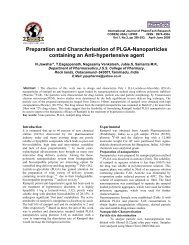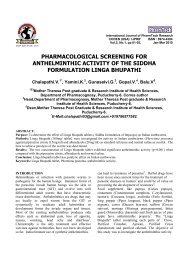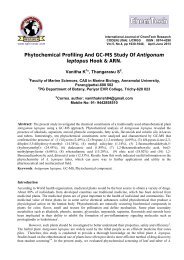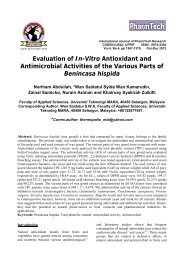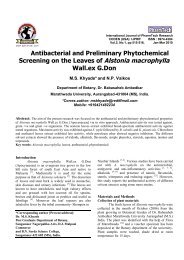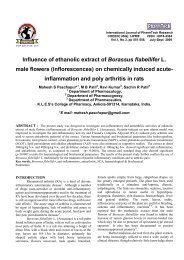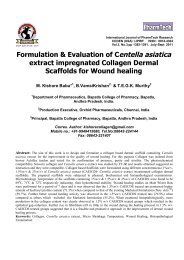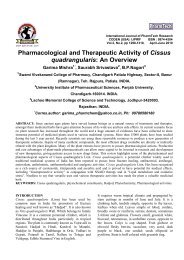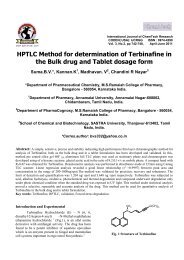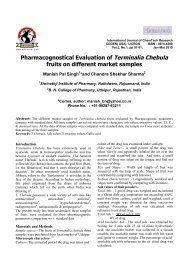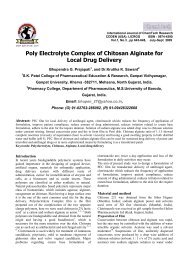Antibacterial and Antifungal activity from leaves - Research Journal ...
Antibacterial and Antifungal activity from leaves - Research Journal ...
Antibacterial and Antifungal activity from leaves - Research Journal ...
Create successful ePaper yourself
Turn your PDF publications into a flip-book with our unique Google optimized e-Paper software.
International <strong>Journal</strong> of PharmTech <strong>Research</strong><br />
CODEN (USA): IJPRIF ISSN : 0974-4304<br />
Vol.3, No.4, pp 2195-2198, Oct-Dec 2011<br />
<strong>Antibacterial</strong> <strong>and</strong> <strong>Antifungal</strong> <strong>activity</strong> <strong>from</strong><br />
<strong>leaves</strong> extract of Corchorus fascicularis Lam.<br />
A. P. Rajput 1 *, Tejendra A. Rajput 2<br />
* 1 P.G. <strong>Research</strong> Center, Department of Chemistry, Z. B. Patil College,<br />
Dhule (M.S.) India.<br />
2 R.C. Patel ACS College, Shirpur, Dist. Dhule. (M. S.) India.<br />
*Corres.author: aprajput@rediffmail.com<br />
Mobile: +919423491139 Fax: (+912562) 220678<br />
Abstract: Since the beginning of modern drug treatments on various diseases, traditional medicine has greatly<br />
played important role in societies. Only limited numbers of medicinal plants have received detailed scientific<br />
scrutiny. World Health Organization (WHO) recommends that this area can be comprehensively investigated. The<br />
aim of present study is to asses the antimicrobial <strong>activity</strong> <strong>and</strong> to determine the zone inhibition of extracts on some<br />
bacterial <strong>and</strong> fungal strains. In the present study, the microbial <strong>activity</strong> of ethanol, n-Hexane, Chloroform <strong>and</strong> water<br />
extracts of <strong>leaves</strong> of Corchorus fascicularis L. were evaluated for potential antimicrobial <strong>activity</strong> against medically<br />
important bacterial <strong>and</strong> fungal strains. The antimicrobial <strong>activity</strong> was determined in all extracts by using agar disc<br />
diffusion method. Extracts were good effective on tested microorganisms. The antibacterial <strong>and</strong> antifungal<br />
activities of solvent extracts of Corchorus fascicularis L. were tested against one gram positive, one gram negative<br />
human pathogenic bacteria <strong>and</strong> one fungi respectively. All the extracts showed broad spectrum of inhibition by<br />
showing antibacterial effect of both bacterial strains. The tested bacterial strains were S. aureus, E. coli <strong>and</strong> fungal<br />
strains was C. albicans. The antimicrobial <strong>activity</strong> of these extracts due to presence of secondary metabolites.<br />
Hence these plants can be used to discover bioactive natural products that may serve as leads in development of<br />
new pharmaceuticals research.<br />
Keywords: - <strong>Antibacterial</strong> <strong>activity</strong> <strong>Antifungal</strong> <strong>activity</strong> Corchorus fascicularis L.<br />
Introduction<br />
Antibiotics are one of our most important weapons in<br />
fighting bacterial infections. However <strong>from</strong> past few<br />
decades these health benefits are under threat. Many<br />
antibiotics become less effective against certain illness<br />
not only because many of them produce toxic<br />
reactions. In many developing countries, traditional<br />
medicine is one of the primary health care system 1, 2 .<br />
The development of medicinal plant as medicine is<br />
good way. In food producing countries to control<br />
growth of bacterial in the product is important. The<br />
most common bacteria causing food borne illness are<br />
S. aureus, E. coli <strong>and</strong> others 3, 4 . Natural products of<br />
higher plants may give new source of antimicrobial<br />
agents with novel mechanisms of action 5, 6 .<br />
Corchorus fascicularis L. commonly called as<br />
Hirankhuri is an annual herb found in throughout India<br />
<strong>and</strong> also many tropical countries. The <strong>leaves</strong> are tasty<br />
<strong>and</strong> sour. It shows <strong>activity</strong> of laxative, stimulant, tonic<br />
<strong>and</strong> aphrodisiac. The seeds remove tumors, pain<br />
stomach troubles, skin diseases <strong>and</strong> scabies. It is useful<br />
in discharging ulcers 7 . Powder of entire plant is used as<br />
tonic to anemic patient 8 . Corchorus fascicularis L.<br />
shows physiological <strong>activity</strong> 9 . Preliminary<br />
phytochemical study of <strong>leaves</strong> of Corchorus<br />
fascicularis L. shows that presence of flavonoids,<br />
terpenoids, steroids, phenol & tannins, saponins,
A. P. Rajput et al /Int.J. PharmTech Res.2011,3(4) 2196<br />
glycosides <strong>and</strong> alkaloids 10 . In Ayurvedic system of<br />
medicines this plant has a large dem<strong>and</strong> due to its uses<br />
in the treatment of many chronic <strong>and</strong> acute diseases<br />
<strong>and</strong> disorders. In continuation of work of<br />
phytochemical studies of various plants we are<br />
presenting of this paper on Corchorus fascicularis L 11,<br />
12 .<br />
Material <strong>and</strong> Methods<br />
Plant Material Collection <strong>and</strong> Authentication<br />
The <strong>leaves</strong> of plant Corchorus fascicularis L. were<br />
collected <strong>from</strong> village T<strong>and</strong>e of Shirpur tehasil in<br />
Dhule district (MS). The specimens of plants were<br />
authenticated by Dr. L.K. Kshirsagar, Department of<br />
Botany, S.S.V.P.S’s L. K. Dr. Ghogrey Science<br />
College, Dhule (MS). The dried uniform <strong>leaves</strong><br />
powder was used for the extraction of constituents of<br />
the plant, determination of ash values, extractive<br />
values <strong>and</strong> phytochemical investigation.<br />
Drying <strong>and</strong> Pulverization<br />
Leaves of Corchorus fascicularis L. were shade dried<br />
<strong>and</strong> pulverized <strong>and</strong> stored in an air tight container for<br />
future use.<br />
Extraction of Powdered <strong>leaves</strong><br />
The extraction of Corchorus fascicularis L. <strong>leaves</strong><br />
were carried out using known st<strong>and</strong>ard procedures 13 .<br />
The powdered <strong>leaves</strong> were successively extracted by<br />
cold maceration process using organic solvents like<br />
ethanol, n-hexane, chloroform <strong>and</strong> water. All the<br />
extracts were evaporated to dryness <strong>and</strong> stored for<br />
future use.<br />
Preliminary Phytochemical Screening<br />
The extracts were subjected to preliminary<br />
Phytochemical screening for the presence of different<br />
chemical groups of compounds. Air dried powdered<br />
plant material were screened for the presence of<br />
saponins, tannins, flavonoids, steroids, triterpenoids,<br />
proteins, glycosides, carbohydrates as described in<br />
literatures 14,15,16 .<br />
Test Microorganisms <strong>and</strong> Growth Media<br />
S. aureus (NCIM 2079), E. coli (NCIM 2169) <strong>and</strong><br />
fungal strain C. albicans (NCIM 3471) were chosen<br />
based upon their clinical <strong>and</strong> pharmacological<br />
importance 17 . The bacterial strains obtained <strong>from</strong><br />
NCIM Pune were used for evaluating antimicrobial<br />
<strong>activity</strong>. The bacterial <strong>and</strong> fungal stock cultures were<br />
incubated for 24 Hrs. at 37 0 C on Nutrient Agar <strong>and</strong><br />
MGYP respectively, following refrigeration storage at<br />
4 0 C. The bacterial strains were grown in Muller<br />
Hinton agar at 37 0 C whereas the yeast were grown in<br />
MGYP respectively at 28 0 C. The stock cultures were<br />
maintained at 4 0 C.<br />
Antimicrobial <strong>activity</strong><br />
In vitro antibacterial <strong>and</strong> antifungal <strong>activity</strong> were<br />
examined for ethanol, n-Hexane, chloroform <strong>and</strong> water<br />
extracts. <strong>Antibacterial</strong> <strong>and</strong> antifungal activities of these<br />
extracts against two pathogenic bacteria <strong>and</strong> one<br />
pathogenic fungi were investigated by the Agar Disk<br />
Diffusion method 18, 19, 20 . All the extracts were screened<br />
for their antibacterial <strong>and</strong> antifungal activities against<br />
the S.aureus, E. coli <strong>and</strong> fungi strain C. albicans. The<br />
dilutions of C. fascicularis L. extracts <strong>and</strong> st<strong>and</strong>ard<br />
drugs were prepared in double distilled water using<br />
nutrient agar tubes. Muller Hinton sterile agar plates<br />
were seeded with bacterial strains (1 x 10 8 bacteria/ ml)<br />
<strong>and</strong> allowed to stay at 37 0 C for 3 hrs. Control<br />
experiments were carried out under similar condition<br />
by using Chloroamphenicol for antibacterial <strong>activity</strong><br />
<strong>and</strong> Nyastatin for antifungal <strong>activity</strong> as st<strong>and</strong>ard drugs.<br />
All the plates were incubated at 37°C for 18 to 24 hrs<br />
for bacteria <strong>and</strong> at 28°C for 48 to 96 hrs for fungi. The<br />
zones of growth inhibition around the disks were<br />
measured after 18 to 24 hrs of incubation at 37°C for<br />
bacteria <strong>and</strong> 48 to 96 h for fungi at 28°C, respectively.<br />
The sensitivity of the microorganism species to the<br />
plant extracts was determined by measuring the sizes<br />
of inhibitory zones (including the diameter of disk) on<br />
the agar surface around the disks.<br />
Table 1: <strong>Antibacterial</strong> <strong>activity</strong> of extracts of C. fascicularis L. against bacterial test organism.<br />
Zone Of Inhibition in mm<br />
Concentration in 100 μg/ml<br />
Microorganism Ethanol n-Hexane Chloroform Aqueous Chloroamphenicol<br />
Extract Extract Extract Extract St<strong>and</strong>ard<br />
E. coli 17.76 13.61 15.00 15.01 20.52<br />
S. aureus 16.30 15.41 14.18 15.09 30.94
A. P. Rajput et al /Int.J. PharmTech Res.2011,3(4) 2197<br />
Table 2: <strong>Antifungal</strong> <strong>activity</strong> of extracts of C. fascicularis L. against bacterial test Organism.<br />
Zone Of Inhibition in mm<br />
Microorganism Ethanol<br />
Extract<br />
n-Hexane<br />
Extract<br />
Concentration in 100 μg/ml<br />
Chloroform<br />
Extract<br />
Aqueous<br />
Extract<br />
Nyastatin<br />
St<strong>and</strong>ard<br />
C. albicans 9.80 8.15 9.73 8.92 9.53<br />
Figure 1: <strong>Antibacterial</strong> Activity Against E. coli <strong>and</strong> S. Aureus.<br />
(#EE- Ethanol extract, HE- n-Hexane extract, CE- Chloroform extract, AE- Aqueous extract)<br />
Figure 2: <strong>Antifungal</strong> Activity Against C. albicans.<br />
(#EE- Ethanol extract, HE- n-Hexane extract, CE- Chloroform extract, AE- Aqueous extract)<br />
Result <strong>and</strong> Discussion<br />
The anti microbial <strong>activity</strong> of all the extracts of C.<br />
fascicularis L. were studied with concentration 100<br />
μg/ml against two pathogenic bacterial strains <strong>and</strong> one<br />
fungal strain. <strong>Antibacterial</strong> <strong>and</strong> antifungal potential of<br />
extracts assessed in terms of zone of inhibition of<br />
bacterial growth. The results of antimicrobial activities<br />
are presented in Table 1-2. The growth of inhibition<br />
zone measured ranged <strong>from</strong> 15-18 mm for sensitive<br />
bacteria <strong>and</strong> ranged <strong>from</strong> 08-10 mm for fungal strains.<br />
The graphical results are presented in figure 1 <strong>and</strong> 2.<br />
The inhibitory effect of C. fascicularis L. <strong>leaves</strong><br />
ethanol, n-Hexane, chloroform <strong>and</strong> aqueous extracts<br />
showed at 17.76, 13.61, 15.00, 15.01 mm for E. coli,<br />
16.30, 15.41, 14.18, 15.09 mm for S. aureus <strong>and</strong> 9.80,
A. P. Rajput et al /Int.J. PharmTech Res.2011,3(4) 2198<br />
8.15, 9.73, 8.92 for C. albicans respectively, The<br />
results showed that C. fascicularis L. <strong>leaves</strong> extracts<br />
were found to be effective against all the microbes<br />
tested.<br />
References<br />
1. Fransworth N.R., Ethnopharmacology <strong>and</strong> future<br />
drug development. The North American<br />
Experience. <strong>Journal</strong> of Ethnopharmacolo, 1993,<br />
38,145-152.<br />
2. Houghton P.J., The role of plants in tradition<br />
medicine <strong>and</strong> current therapy. <strong>Journal</strong> of Altern<br />
<strong>and</strong> Complement Med, 1995, 1,131-143.<br />
3. Van T. T. H., Moutafis G., Tran L. T., Coloe<br />
P.J., Antibiotics resistance in food borne<br />
diseases <strong>from</strong> food animals in Thail<strong>and</strong>. J.Vet.<br />
Med. Sci, 2007, 70, 873-879.<br />
4. Gerner-Smidt P., Whichard J.M., Foodborne<br />
diseases trends <strong>and</strong> report: Foodborne Pathogens<br />
Dis, 2008, 5: 551-554.<br />
5. Runyoro D., Matee M., Olipa N., Joseph C.,<br />
Mbwambo H., Screening of Tanzanian<br />
medicinal plants for anti- C<strong>and</strong>ida <strong>activity</strong>.<br />
BMC Complement Altern Med, 2006, 6 (11).<br />
6. Shahidi B. H., Evaluation of antimicrobial<br />
properties of Iranian medicinal plants against<br />
Micrococcus luteus, Serratia marcescens,<br />
Klebsiella Pneumoniae <strong>and</strong> Bordetella<br />
bronchoseptica. Asian J Plant Sci, 2004, 3, 82-<br />
86.<br />
7. Kirtikar K.R., Basu B.D., Indian Medicinal<br />
Plants, International Book Distributor,<br />
Dehradun, 1996,401-402..<br />
8. Patil D.A., Flora of Dhule <strong>and</strong> N<strong>and</strong>urbar<br />
Districts, Sing Bishen Publishers, Dehradun,<br />
2003, 112-113.<br />
9. Hossen M, Ali M.S., Begum M, Khatton <strong>and</strong><br />
Halim A., Jour. Innov Dev Strategy 2008, 3,<br />
71-73.<br />
Acknowledgment :Authors are thankful to Principal<br />
Z.B. Patil College Dhule, Management R.C. Patel<br />
Educational Trust <strong>and</strong> Principal R.C. Patel ACS<br />
College Shirpur, Dist. Dhule (MS) India for availing<br />
all necessary facilities.<br />
*****<br />
10. Rajput A. P., Rajput T. A., Pharmacognostic &<br />
preliminary phytochemical investigation of<br />
corchorus fascicularis Lam. Leaves. Int J<br />
Pharmcy Pharm Sci, 2011, 3(5).<br />
11. Rajput A.P. <strong>and</strong> Yadav S.S., Jour Phyto Res,<br />
2000, 3,161-66.<br />
12. Rajput A. P., Asian <strong>Journal</strong> of Chemistry, 2000,<br />
14,795-98.<br />
13. Harborne J.B., Phytochemical Methods,<br />
Chapmann <strong>and</strong> Hall, London, 1984, 168-170.<br />
14. Tariq M, Bhardwaj S.L., Sharma R.C., Gupta<br />
S.K., Gupta L. Pharmacological studies in the<br />
glycoside isolated <strong>from</strong> corchorus fascicularis<br />
Lam. Jour Ind Exp Biology, 1973, 11, 248-249.<br />
15. Kh<strong>and</strong>elwal K.R., Practical Pharmacognosy,<br />
Nirali Prakashan, Pune, 2005, 117-30.<br />
16. Kokate C.K., Gokhale S.B., Purohit A.P.,<br />
Pharmacognosy, Nirali Prakashan, Pune,<br />
2004,101-110.<br />
17. Mc Cracken W.A., Cowsan R.A., Clinical <strong>and</strong><br />
Oral Microbiology, New York, Hemisphere<br />
Publishing Corporation, 1983,512.<br />
18. Kumar A., Ilavarasan R., Jayach<strong>and</strong>ran,<br />
Decaraman M., Aravindhan P., Phytochemical<br />
Investigation on a tropical plant in South India,<br />
Pakistan <strong>Journal</strong> of Nutrition, 2009, 8(1),83-85.<br />
19. Alzoreky N.S., Nakahara K., <strong>Antibacterial</strong><br />
<strong>activity</strong> of extracts <strong>from</strong> some edible plants<br />
commonly consumed in Asia. International<br />
<strong>Journal</strong> of Food Microbiology, 2003, 80, 223–<br />
230.<br />
20. Bauer A. W., Kirby W.M.M., Sherris, J.C.,<br />
Turck,M., Antibiotic susceptibility testing by<br />
st<strong>and</strong>ardized single disc method. American<br />
<strong>Journal</strong> of Clinical Pathology. 1966, 36, 493–<br />
496.



